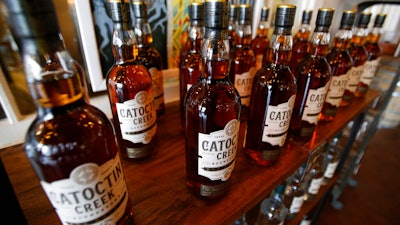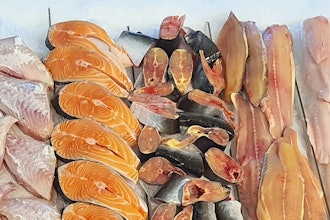
LOUISVILLE, Ky. (AP) — American whiskey producers raised a glass to celebrate a trans-Atlantic agreement to end retaliatory tariffs that sank their sales in Europe. Now comes the challenge of rebuilding brands that were stymied in those ultra-competitive markets during the lengthy trade dispute.
Tasked with ramping up distribution networks in some their industry's largest overseas markets, producers of bourbon, Tennessee whiskey and rye whiskey also have to overcome problems in the global supply chain from the COVID-19 pandemic.
But whiskey producers sounded optimistic Monday about reviving growth strategies for European markets after the U.S. and European Union announced a weekend agreement to settle their diplomatic rift over Trump-era steel and aluminum tariffs. American whiskey became collateral damage when the EU slapped a retaliatory tariff on those spirits in mid-2018.
“This is an amazing reprieve -- nothing but happiness and jubilation,” Amir Peay, owner of the Lexington, Kentucky-based James E. Pepper Distillery, said. "There are some obstacles and problems that we will need to deal with, as will everybody. But that’s business.”
There's plenty of lost market share to make up in the EU.
American whiskey exports to the EU plunged by 37%, from $702 million to $440 million, from 2018 to 2020, according to the Distilled Spirits Council of the United States.
For Kentucky bourbon producers, sales to the EU plummeted by nearly 50% in 2020 alone, the Kentucky Distillers' Association said. The EU accounted for 56% of all Kentucky whiskey exports in 2017 — the year before the tariffs hit — but its share shrank to about 40% by 2020.
In touting the agreement by President Joe Biden's administration to settle the trade dispute, U.S. Commerce Secretary Gina Raimondo said “this deal is good for Kentucky’s workers and the iconic Kentucky bourbon industry."
Kentucky Gov. Andy Beshear said Monday that Raimondo “went to bat” for the state, pointing to their multiple conversations about how hard the EU tariff was hitting Kentucky's distilling sector.
The EU targeted American whiskey and other U.S. products in response to then-President Donald Trump’s decision to impose tariffs on European steel and aluminum.
Tariffs amount to a tax, which producers could either absorb in reduced profits, or pass along to customers through higher prices — and risk losing market share in competitive markets.
With the trade barrier coming down, Catoctin Creek Distillery in Virginia is looking to start reshipping its rye whiskey to EU markets, said Scott Harris, the distillery's co-founder and general manager.
“We have a chance to go over to Europe now and compete fairly and bring our products back in at competitive prices," he said. “This is what we've been waiting for the whole time.”
But it could take a few years to regain the lost European business, Harris said.
Distillers will have to decide how much of their finite whiskey supplies will ship to Europe. They can't simply crank up production for immediate inventory bumps. Most bourbons typically age four to eight years before reaching market, getting their flavor and golden brown color during aging.
That patience will be necessary for American distillers in winning back space on EU liquor shelves, Peay said. His Kentucky distillery’s signature bourbon and rye brand is James E. Pepper 1776.
“It’s not easy to repair the damage that’s been done,” he said, adding recovery will be complicated further by supply chain woes brought on by the pandemic. And there's still a lingering United Kingdom tariff on American whiskey owing to a separate trade dispute.
Nonetheless, he predicted a European comeback for U.S. spirits in the next few years, adding, “we are going to start seeing some serious mojo come back into Europe from the American whiskey space.”






















